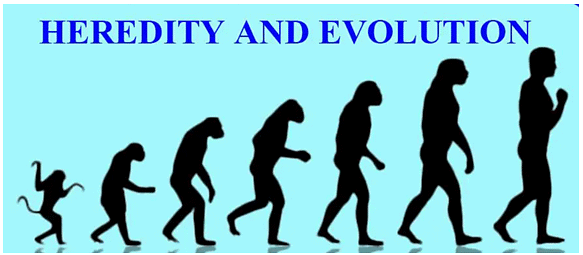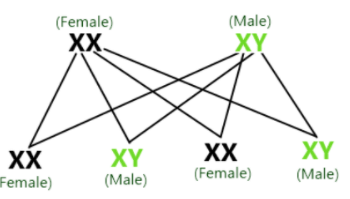Olympiad Notes: Heredity and Evolution | Olympiad Preparation for Class 10 PDF Download

Heredity
It is the phenomenon of transfer of characters from parents to their offspring.
Variation: The differences shown among individuals of the same species or the differences exhibited by the offspring as compared to the parents are called variation.
Genetics: It is the study of heredity and variation. We all know our body is made up of many cells. In cells, we have a nucleus that has chromatin material which further condenses to form ribbon-shaped ribbon chromosomes.
These chromosomes are made up of DNA and proteins and they also have certain small segments on them that are genes. These genes are responsible for transferring characters from parents to offspring.
The cells in our body are generally of two types:
- Somatic cells (self-replicating)
- Sex cells (sperm and egg)
He selected pea plant as an experimental plant because:
- It has 7 distinct easily contrasting characters
- Short life cycle
- Easily available
- Annual herb
- It doesn’t require much care.
- It produces a large number of seeds.
He formulated various laws:
- Law of Unit Character
- Law of dominance
- Law of segregation
- Law of Independent assortment
Two types of crosses:
- Monohybrid cross
- Dihybrid cross
Sex determination
It is the process by which sex of a child is determined. In human beings, a somatic cell contains 23 pairs of chromosomes, i.e. 46 chromosomes. Out of them, 22 pairs have similar chromosomes. These are called autosomes. The chromosomes in the 23rd pair can be different and are called heterosomes. Chromosomes of the 23rd pair are also called sex chromosomes because they determine if a zygote would develop into a male child or a girl child. Let us take and example to understand this-
It can be concluded that:
- There is a 50-50% chance of a boy or a girl.
- The sex of a child depend on the father because he produces different types of gametes.
Evolution and classification
We have studied that there is an inbuilt tendency in every organism to carry variation because of DNA copying during reproduction. As a result of sexual reproduction, genetic variations give rise to evolution. Some variations are developed during the lifetime of an organism. Such variations are called acquired variations and these variations have no role in evolution.
We can define evolution as:
It is the gradual sequence of changes that took place over the years and lead to the development of entirely new species:
If evolution has taken place there must be proof to it that proves the evolution. We must be thinking that we should have some evidence to prove the occurrence of evolution:
Different pieces of evidence that prove that evolution takes place are :
- Fossils: The dead remains of plants and animals that got buried under the earth over millions of years ago. “The study of fossils is called Paleontology”. Fossil reveals the order of origin i.e.
Protozoans → fishes → amphibians → reptiles → birds → mammals - Archaeopteryx: It is a fossil that resembles birds as well as reptiles. We can say that it is a link between reptiles and birds.
- Homologous Organs: They are those which have the same structure but perform different functions. Example: Forelimbs of a man and cow.
- Analogous Organs: They are those which have a different structure but perform the same function. Example: wings of birds & insects
- Vestigial Organs: They are those which were functional in our ancestors but now they are not functional. Example: nictitating membrane, pinna muscles & vermiform appendix (man).
- Embryology: It is the study of the development of an embryo. This study reveals that all organisms of different species that have common ancestors.
- Biogenetic Law: According to this law ontogeny recapitulates phylogeny. This means that during the development of embryo complete history is repeated.
Theory of Evolution
- The use or disuse of organs makes the organ efficient or less efficient.
- Favorable characteristics are passed on to the next generation.
- Accumulation of new characters leads to evolution.
Darwin theory
- The population is increasing day by day, but still, the population rate is constant.
- Individuals of different species struggle for food, space, and mate.
- Those who can struggle to survive, others are eliminated.
- Favourable characters pass on to the next generation.
- Accumulation of new characters leads to evolution.
Speciation
- It is the formation of new species from pre-existing ones.
- A new species may be formed from the population occurring in different areas of distribution: allopatric speciation.
- A new species formed from fragments of the population in the same area due to mutation: sympatric speciation.
- Microevolution: It is the formation of species due to small but significant changes like gene mutation and gene recombination.
- Macroevolution: It is the development of different genres and taxa.
|
70 videos|242 docs|187 tests
|
FAQs on Olympiad Notes: Heredity and Evolution - Olympiad Preparation for Class 10
| 1. What is heredity and how does it relate to traits in organisms? |  |
| 2. How does evolution occur in living organisms? |  |
| 3. What is the significance of classification in biology? |  |
| 4. What are the main differences between inherited traits and acquired traits? |  |
| 5. How do mutations contribute to the process of evolution? |  |
















